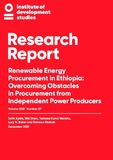Renewable Energy Procurement in Ethiopia: Overcoming Obstacles in Procurement from Independent Power Producers
| dc.contributor.author | Ayele, Seife | |
| dc.contributor.author | Shen, Wei | |
| dc.contributor.author | Worako, Tadesse Kuma | |
| dc.contributor.author | Baker, Lucy H. | |
| dc.contributor.author | Hadush, Samson | |
| dc.coverage.spatial | Ethiopia | en |
| dc.date.accessioned | 2021-12-16T11:51:59Z | |
| dc.date.available | 2021-12-16T11:51:59Z | |
| dc.date.issued | 2021-12-16 | |
| dc.identifier.citation | Ayele, S.; Shen, W.; Worako, T.K.; Baker, L.H. and Hadush, S. (2021) Renewable Energy Procurement in Ethiopia: Overcoming Obstacles in Procurement from Independent Power Producers, IDS Research Report 87, Brighton: Institute of Development Studies, DOI: 10.19088/IDS.2021.064 | en |
| dc.identifier.isbn | 978-1-78118-891-0 | |
| dc.identifier.issn | 0141-1314 | |
| dc.identifier.uri | https://opendocs.ids.ac.uk/opendocs/handle/20.500.12413/17010 | |
| dc.description.abstract | Developing countries are increasingly using auctions for the procurement of utility-scale renewable electricity, due to the potential for attracting private investment. However, auction design and implementation can face serious obstacles due to complex context-specific factors. In 2017, Ethiopia launched its Public–Private Partnership (PPP) policy and procurement framework to promote infrastructure development, including electricity generation. Since 2018, it has organised renewable energy auctions to procure new capacity from independent power producers (IPPs). However, the new framework faces numerous challenges. Using a literature review and primary data from more than 70 interviews and from stakeholder consultations, this study explores the political economy challenges and opportunities facing IPP project preparation, decision-making, coordination and implementation, and risks to investors. To date, Ethiopia has held two rounds of tenders to procure 1,000 megawatts (MW) of electricity from eight projects; the first tender for two solar photovoltaic (PV) projects led to the signing of Power Purchase Agreements (PPAs) and was hailed as one of the cheapest tariff rates in sub-Saharan Africa, at US$2.526 cents/kilowatt hour (kWh) over 25 years. However, none of the projects have yet become operational. This study also finds fault lines impeding the implementation of IPP projects, including the risk of foreign currency availability and convertibility of Ethiopian birr to expatriate profits. It proposes measures to overcome these obstacles and mitigate risks, to put Ethiopia on course to achieve universal access to electricity by 2030. | en |
| dc.description.sponsorship | Foreign, Commonwealth & Development Office | en |
| dc.language.iso | en | en |
| dc.publisher | Institute of Development Studies | en |
| dc.relation.ispartofseries | IDS Research Report;87 | |
| dc.rights | This is an Open Access report distributed under the terms of the Creative Commons Attribution 4.0 International licence (CC BY), which permits unrestricted use, distribution, and reproduction in any medium, provided the original authors and source are credited and any modifications or adaptations are indicated. | en |
| dc.rights.uri | http://creativecommons.org/licenses/by/4.0/ | en |
| dc.subject | Development Policy | en |
| dc.subject | Industrial Development | en |
| dc.subject | Trade | en |
| dc.title | Renewable Energy Procurement in Ethiopia: Overcoming Obstacles in Procurement from Independent Power Producers | en |
| dc.type | IDS Research Report | en |
| dc.rights.holder | Institute of Development Studies | en |
| dc.identifier.team | Green Transformations | en |
| dc.identifier.doi | 10.19088/IDS.2021.064 | |
| rioxxterms.funder | Default funder | en |
| rioxxterms.identifier.project | Default project | en |
| rioxxterms.version | VoR | en |
| rioxxterms.versionofrecord | 10.19088/IDS.2021.064 | en |
| rioxxterms.funder.project | 9ce4e4dc-26e9-4d78-96e9-15e4dcac0642 | en |
Files in this item
This item appears in the following Collection(s)
-
IDS Research [1671]
Except where otherwise noted, this item's license is described as This is an Open Access report distributed under the terms of the Creative Commons Attribution 4.0 International licence (CC BY), which permits unrestricted use, distribution, and reproduction in any medium, provided the original authors and source are credited and any modifications or adaptations are indicated.


